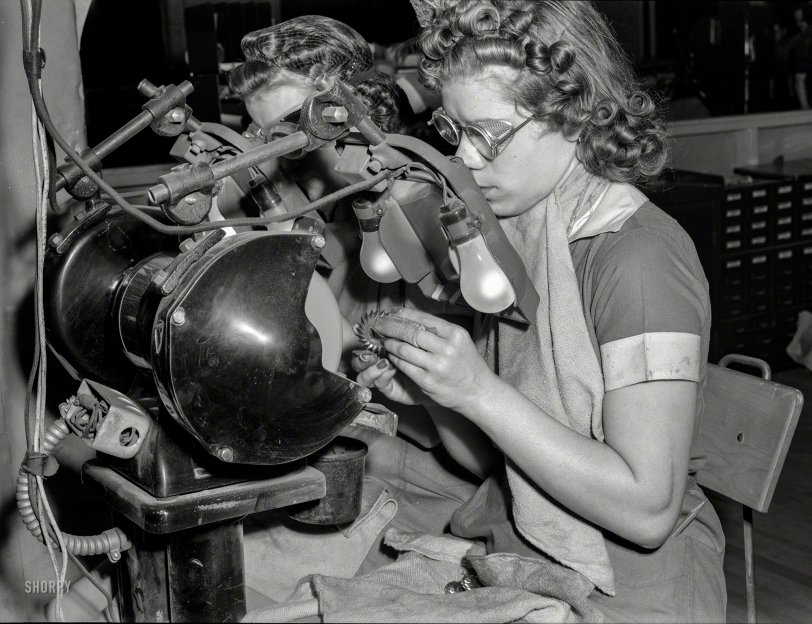


Framed or unframed, desk size to sofa size, printed by us in Arizona and Alabama since 2007. Explore now.
Shorpy is funded by you. Patreon contributors get an ad-free experience.
Learn more.

- Details, Details
- What's that building to the left of the tower?
- Coal Barges
- Bromo-Seltzer
- Inner harbor
- The Basin
- What a headache!
- Giant stepladder?
- Baldwin 62303
- Baldwin VO-1000
- Cold
- No expense spared
- Tough Guys
- Lost in Toyland
- And without gloves
- If I were a blindfolded time traveler
- Smoke Consumer Also Cooks
- Oh that stove!
- Possibly still there?
- What?!?
- $100 Reward
- Freeze Frame
- Texas Flyer wanted
- Just a Year Too Soon
- WWII -- Replacing men with women at the railroad crossing.
- Yes, Icing
- You kids drive me nuts!
- NOT An Easy Job
- I wonder
- Just add window boxes
Print Emporium
War Machinists: 1942

August 1942. "Women in industry. Sharp eyes and agile fingers make these young women ideal machine operators. They're conditioning and reshaping milling cutters in a huge Midwest machine tool company. Republic Drill and Tool, Chicago." Photo by Ann Rosener, Office of War Information. View full size.
Burrs
I think they might be just grinding off burrs left by a gear cutter. The lady is wearing what we called finger savers. It's dangerous to have that scarf like thing around her neck near a grinding wheel.
August, not so much...
but I guess those lamps probably kept those fingers toasty warm in a war plant in the winter in Illinois. Factories had very little "climate control," especially year-round until the late 80s when some geniuses realized that micro-dimensions were affected by shop conditions when machined, and not just to keep employees comfortable. I do not miss a lot of my younger years in those places; the naivete of the young engineers I shall treasure - another story (or twelve), another day.
Re-Purposing
If the chips and carbon spots can be removed, the face can be re-sharpened in the same diameter as before, if not a new outside diameter (O.D.)can be achieved. Most WWII tooling was made to be reused if possible, then re-purposed when necessary. Face cutting on surfaces did not always need a certain O.D., the cuts only needed to overlap (while being straight and parallel)for a smooth face. Much of the WWII arsenal was made by utilizing tooling most engineers thought to be used only briefly. A few dozen (hundred) extra parts were, in effect, a bonus, since the running changes were minimal.
Grinding out nicks
I bet they are grinding out nicks or dings on the teeth, the cutter will then be put on a sharpening machine. The cutter will cut smaller after resharpening, but it cuts just as well. During the war a lot of cutters were saved this way.
Hand Sharpening
I'm sure these ladies are grinding "Back Relief" on the cutters as the geometry is not as important and much faster than a machine. I say this as there is no setup required for each cutter. In the old days (1970s), end-mills were still having their back relief geometry developed by hand grinding.
Touching-up a milling cutter freehand!
Milling machine cutters must have all their teeth shaped identically if they are to make a smooth, chatter-free cut. This is usually done by mounting the cutter in a tool and cutter grinder, which has jigs and fixtures to hold various milling cutters for precise grinding of each tooth.
These women are touching-up cutters from a horizontal milling machine freehanded on an ordinary pedestal grinder! I would not have thought this was possible! It would require an incredibly steady hand and a very good eye to do this!
Agile fingers
From the bandages on her fingers it looks like they weren't quite agile enough.
[Those look more like finger guards than bandages to me. -tterrace]
























On Shorpy:
Today’s Top 5